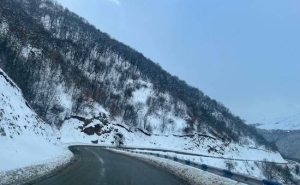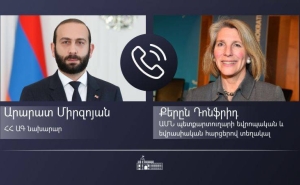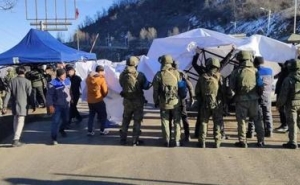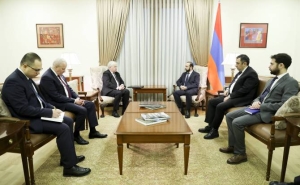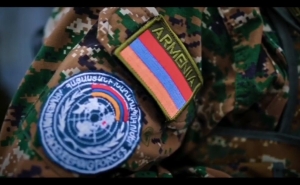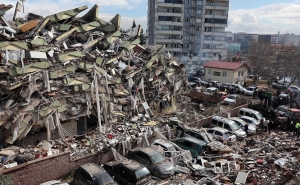US-Armenia Relations: What are the Existing Intergovernmental Tools and Prospects to Develop Cooperation?
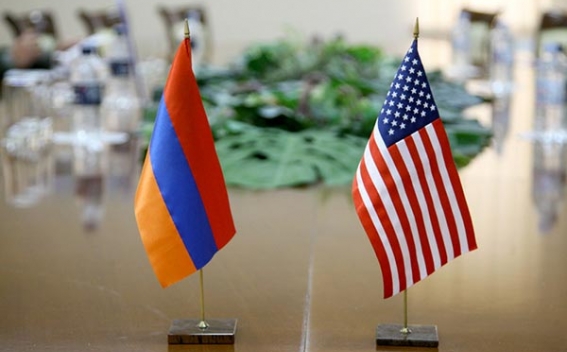
In its multi vector foreign policy the Republic of Armenia has prioritized its relations with the United State of America since its independence. To continue and develop bilateral relations the two states have cooperated in different spheres such as political, economic, human right and democracy, education, civil society and etc. Since the independence there have been more than thirty visits of the high level Armenian officials to the USA, while the visits of the US high level officials to Armenia reached twenty. In addition, during this period tens of bilateral agreements have been signed between the two countries.
The article focuses on the main two intergovernmental tools of the two countries to develop bilateral relations in different spheres. The enumeration of the main tools and the achievements reached so far will allow to estimate their effectiveness and to think of possible changes in the bilateral agenda will further deepen cooperation between the two countries.
The US-Armenia Joint Economic Task Force (USATF) was established in 2000, an intergovernmental commission that meets twice a year to discuss mutual areas of cooperation in energy, trade, and investment. To measure the effectiveness of this commission one can take as an indicator major economic projects realized and the major agreements signed between the US and Armenia so far. The first major one to mention is the largest investment made by the US Company, ContourGlobal, which bought the Vorotan Hydroelectric Cascade ( 250 million dollar worth deal). The investment is beneficial for Armenia not only in terms of financial income but also in terms of introduction of the new technical expertise and management techniques.
Second largest project was realized still in 2006 in the framework of which the grant worth $235,650,000 was given by U.S. Government’s Millennium Challenge Corporation (MCC) to Armenia aimed at reducing rural poverty via improved economic performance in the agricultural sector.
Another achievement reached in the framework of the US-Armenia intergovernmental commission is the US-Armenia Trade and Investment Framework Agreement signed between the two countries in May of the last year, which established United States-Armenia Council on Trade and Investment. As the US ambassador in Armenia Richard Mills himself explained as opposed to the USATF Joint Economic Task Force the newly-established Council on Trade and Investment (the TIFA Council) is a platform to discuss very specific, very technical trade issues, while the former focuses on big-picture, larger economic issues that will affect present and future bilateral relationship between the two countries. To this one can also add Armenia’s status of Permanent Normal Trade Relations (PNTR) (the status that gives trade advantages, such as low tariffs) as well as around 70 American companies that do business in Armenia in such spheres as precious stone processing and jewelry manufacturing, information and communication technology, food processing, mining and tourism.
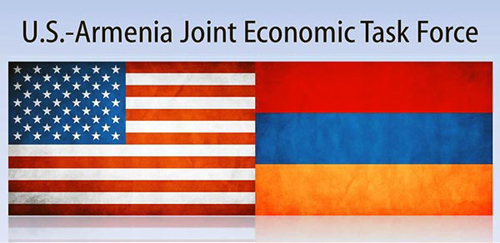
All the agreements and investments reached and made so far speak of the willingness of both sides to continue and develop bilateral relations. However, in terms of their efficiency one should say that there is still work to do. If one pays attention to the nature of the agreements reached it is not difficult to realize that most of them aim at supporting to the Republic of Armenia. To further deepen and strengthen bilateral relations it is high time for the sides to pass from supportive to mutually beneficial economic projects. Such kind of mutually beneficial projects are of high relevance now, when Iran got rid of the Western sanction and the Iranian market has opened for foreign goods. The US companies that would invest in Armenia can highly benefit by exporting their goods to the large Iranian market. The same is true about the Eurasian Union market.
If we pass from executive to legislative branch of intergovernmental cooperation we are to speak about the primary tool that is parliamentary Armenia-USA Friendship Group between the US and Armenia. Before choosing indicators to measure its efficiency we need to refer to the main issues discussed in the agenda of the group. Among them we should identify such major issues as RA national security, the NKR conflict settlement, the Armenian-Turkish relations, the tension at the Azerbaijani border, the RA-USA economic cooperation. As for the economic cooperation here we can use the same indicators as the ones mentioned above. As for other issues one of the possible indicators can be number of resolutions introduced in the current 114th US Congress expressing their stance on the issues included in the agenda. In the House of Representatives (lower house of the Congress) there were 4 bills expressing the interest of the Armenian side among them the recent one on the H.R.4264 -- Azerbaijan Democracy Act of 2015 on Azerbaijan's gross violations of human rights and fundamental freedoms. In the upper house of the US Congress there were 1 bill and 3 resolutions expressing the Armenian interest. To these one can also add the number of the US states that have recognized Armenian Genocide (44 states) and the ones who have recognized the independence of Nagorno-Karabakh Republic (6 states, recent one was the State of Georgia).
However, it will not be fair to estimate the effectiveness of the US-Armenia relations without refereeing to the existing Armenian lobbyist groups in the USA who do a great job on the issues of the Armenian interests. Among them the major once are the Armenian National Committee of America (ANCA), Armenian Revolutionary Federation (ARF) and the Armenian Assembly of America (AAA).
If we try to estimate the level of effectiveness of inter-parliamentary cooperation we are again to state that the Friendship Group as the main tool needs some essential changes in its agenda. So far the main focus of the group has been recognition of the Armenian Genocide. Maybe it is time to use inter-parliamentary connections to reactivate efforts on other major issues such as Karabakh conflict, taking into consideration Azerbaijani current aggression on the borders, war rhetoric, Armenophobia. Another major problem is Armenia's regional blockade, which need to be overcome.
Thus to summarize we are to state that Armenia needs to become more active in its initiatives aimed at deepening cooperation with the US; the initiatives that will not be supportive in their nature but will be based on the common interests of both countries in the region and outside it.
Other materials on this subject
- Turkey is sending Cold War-era cluster bombs to Ukraine – FP The weapons are designed to destroy tanks by bursting into smaller submunitions, which can linger on the battlefield for years if they do not immediately explode. Each round scatters about 88 bomblets.
- Los Angeles mayor and city council president address US president on Lachin corridor issue Thank you, Mayor Bass, for joining me in communicating to President Biden the urgent need for U.S. leadership to lift the blockade and bring humanitarian relief to the people of Artsakh.
- US Committed to Helping Armenia and Azerbaijan Resolve Issues Peacefully: Blinken Spoke With Pashinyan The Secretary reiterated our commitment to helping Armenia and Azerbaijan resolve issues peacefully.
- Iran to Submit Final Conclusion Over Nuclear Deal Revival by Midnight In comments on Monday, Amirabdollahian said Iran is going to send its final conclusion about the JCPOA talks to the European coordinator in written form at midnight.
- Erdogan, Biden Might Meet in September- Media Turkey plans to buy 40 F-16 fighter jets from the US and upgrade another eighty. US President Joe Biden stated that he expects to receive the approval of the [US] Congress to sell F-16 fighter jets to...
-
 17:08
17:08The regular session of the Anti-corruption Policy Council takes place in Jermuk
-
 15:05
15:05The Prime Minister sends congratulatory messages to the supreme leader of Iran and the President of Iran
-
 11:11
11:11Armenia sends earthquake aid to Turkey
-
 10:43
10:43Commemoration of the Pontiff St. Sahak Partev
-
 09:16
09:16Some roads are closed and difficult to pass in Armenia
-
 19:55
19:55Phone conversation of the Foreign Minister of Armenia with the U.S. Assistant Secretary of State for European and Eurasian Affairs
-
 18:30
18:30Prime Minister Pashinyan and President Khachaturyan meet
-
 18:20
18:20Ararat Mirzoyan with Co-Chairman of the OSCE Minsk Group of France Brice Roquefeuil
-
 17:01
17:01Humans could land on Mars within 10 years, Musk predicts
-
 16:45
16:45France, US urge 'immediate' end to Nagorno Karabakh blockade
-
 16:01
16:01Blockaded Nagorno Karabakh launches fundraiser to support quake-hit Syria
-
 15:59
15:59Earthquake death toll in Turkey rises to 18,342
-
 15:43
15:43Ararat Mirzoyan Held a Telephone Conversation with Sergey Lavrov
-
 15:06
15:06French president rules out fighter jet supplies to Ukraine in near future
-
 14:47
14:475 Day Weather Forecast in Armenia
-
 14:44
14:44President Vahagn Khachaturyan wrote a note in the book of condolences opened in the Embassy of Syria in Armenia
-
 14:20
14:20Azerbaijan’s provocations impede establishment of peace and stability – Armenian FM tells Russian Co-Chair of OSCE MG
-
 12:57
12:57France representation to OSCE: Paris calls on Azerbaijan to restore freedom of movement through Lachin corridor
-
 11:40
11:40Command of Kosovo forces highly appreciated preparation of Armenian peacekeepers
-
 10:16
10:16The United States withdrew from sanctions against Syria for six months the provision of assistance after the earthquake
day
week
month
Humidity: %
Wind: km/h


